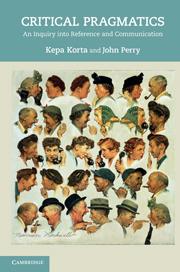Book contents
- Frontmatter
- Contents
- Preface
- Acknowledgments
- 1 Introduction
- 2 A short history of reference
- 3 Acts, roles, and singular reference
- 4 Elements of reference
- 5 Demonstratives
- 6 Context sensitivity and indexicals
- 7 Names
- 8 Definite descriptions
- 9 Implicit reference and unarticulated constituents
- 10 Locutionary content and speech acts
- 11 Reference and implicature
- 12 Semantics, pragmatics, and Critical Pragmatics
- 13 Harnessing information
- 14 Examples
- Bibliography
- Index
8 - Definite descriptions
Published online by Cambridge University Press: 05 March 2013
- Frontmatter
- Contents
- Preface
- Acknowledgments
- 1 Introduction
- 2 A short history of reference
- 3 Acts, roles, and singular reference
- 4 Elements of reference
- 5 Demonstratives
- 6 Context sensitivity and indexicals
- 7 Names
- 8 Definite descriptions
- 9 Implicit reference and unarticulated constituents
- 10 Locutionary content and speech acts
- 11 Reference and implicature
- 12 Semantics, pragmatics, and Critical Pragmatics
- 13 Harnessing information
- 14 Examples
- Bibliography
- Index
Summary
Introduction
Definite descriptions are phrases of the form ‘the F.’ Since Russell, at least, possessives like ‘Caesar's wife’ have also usually been thought of as definite descriptions. Russell saw definite descriptions as members of a class he called ‘denoting phrases’ that includes ‘an F,’ ‘some Fs,’ ‘every F’, and so on. In the general case of denoting phrases, the denotation is the set of objects of which the descriptive phrase is true. In the case of definite descriptions, if there is a unique member of the denoted set, it too is often called the denotation. We'll adopt a somewhat different terminology. For us, the denotation is always a set; we use the term ‘designation’ for the object picked out by a definite description that denotes a singleton set. So, ‘The present king of France’ denotes the null set, but doesn't designate anyone, since that set is empty. ‘The senator from California’ denotes the set consisting of Barbara Boxer and Dianne Feinstein, but doesn't designate anyone, because that set doesn't have a unique member. ‘The largest state in the United States’ denotes the singleton set consisting of Alaska, and so designates Alaska.
Given this, Russell's famous theory of definite descriptions can be summarized as follows:
Definite descriptions are not real syntactic units in a logical language, and are misleadingly so in natural language.
A statement of the form ‘The F is G’ is true if there is a unique F and it is G.
[…]
- Type
- Chapter
- Information
- Critical PragmaticsAn Inquiry into Reference and Communication, pp. 90 - 101Publisher: Cambridge University PressPrint publication year: 2011



